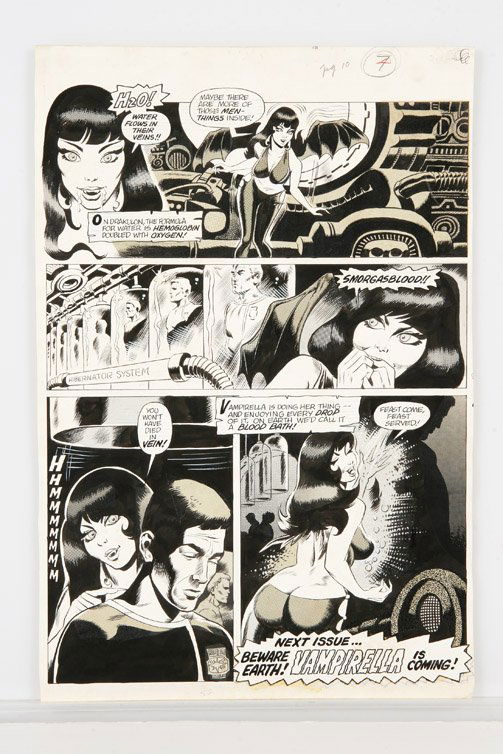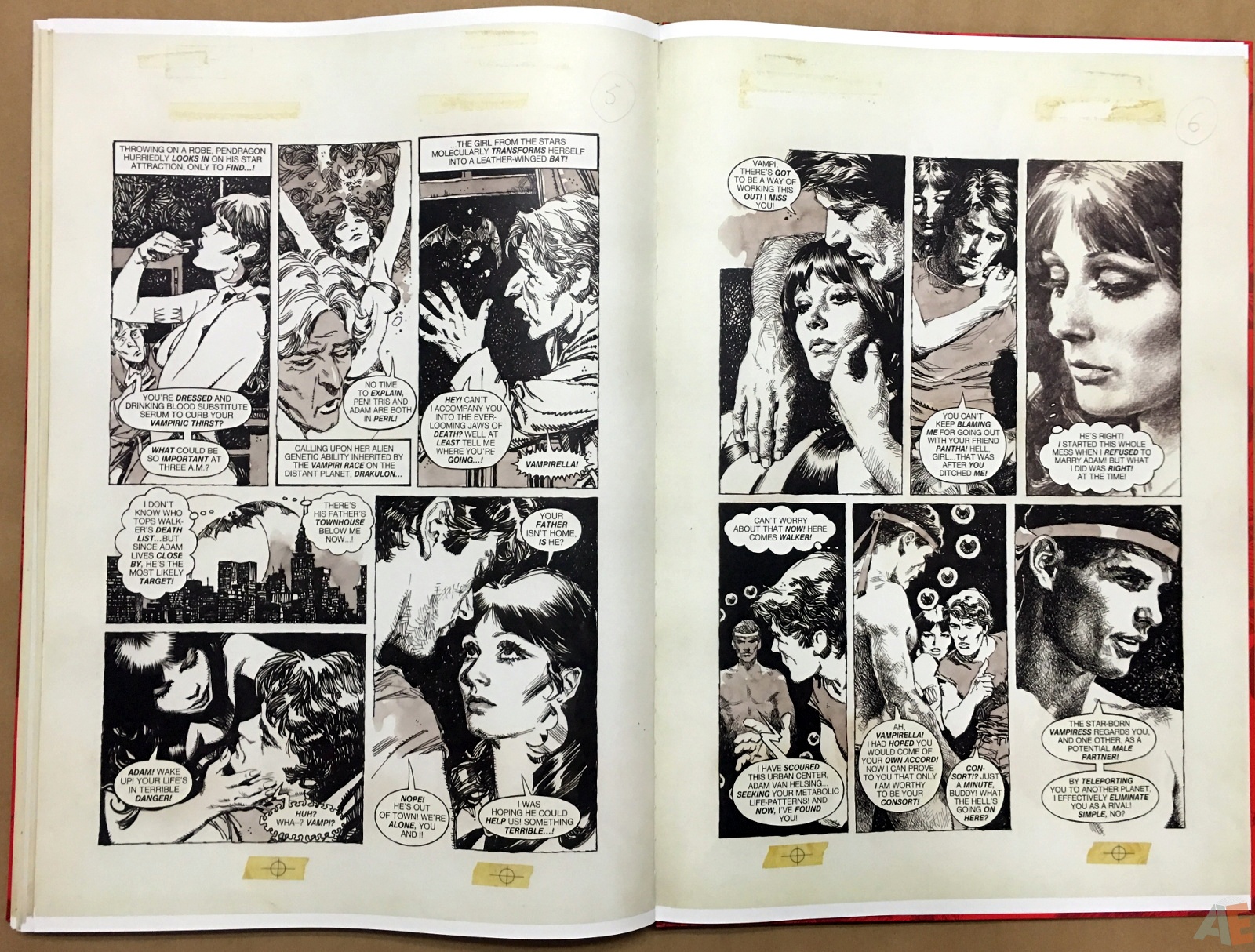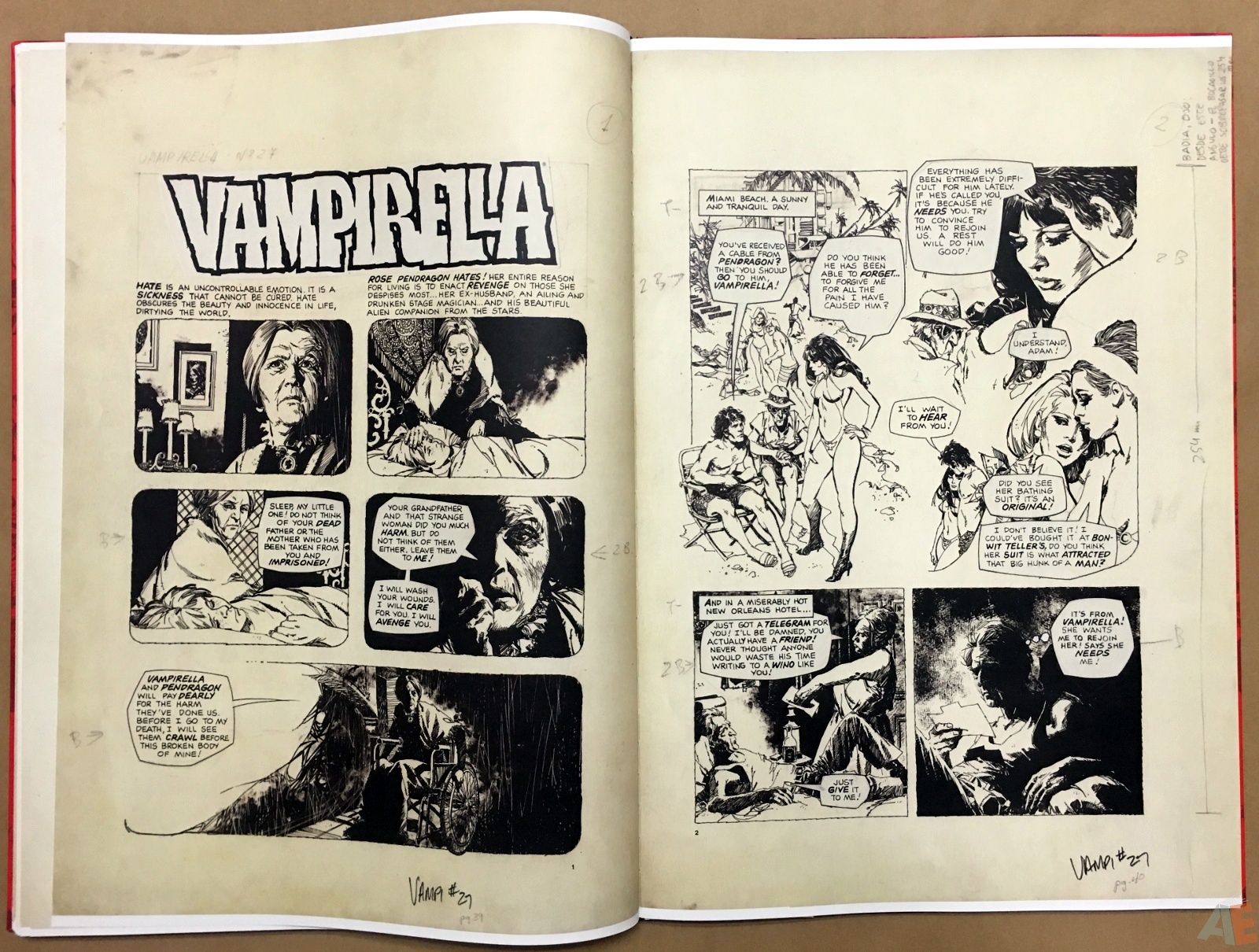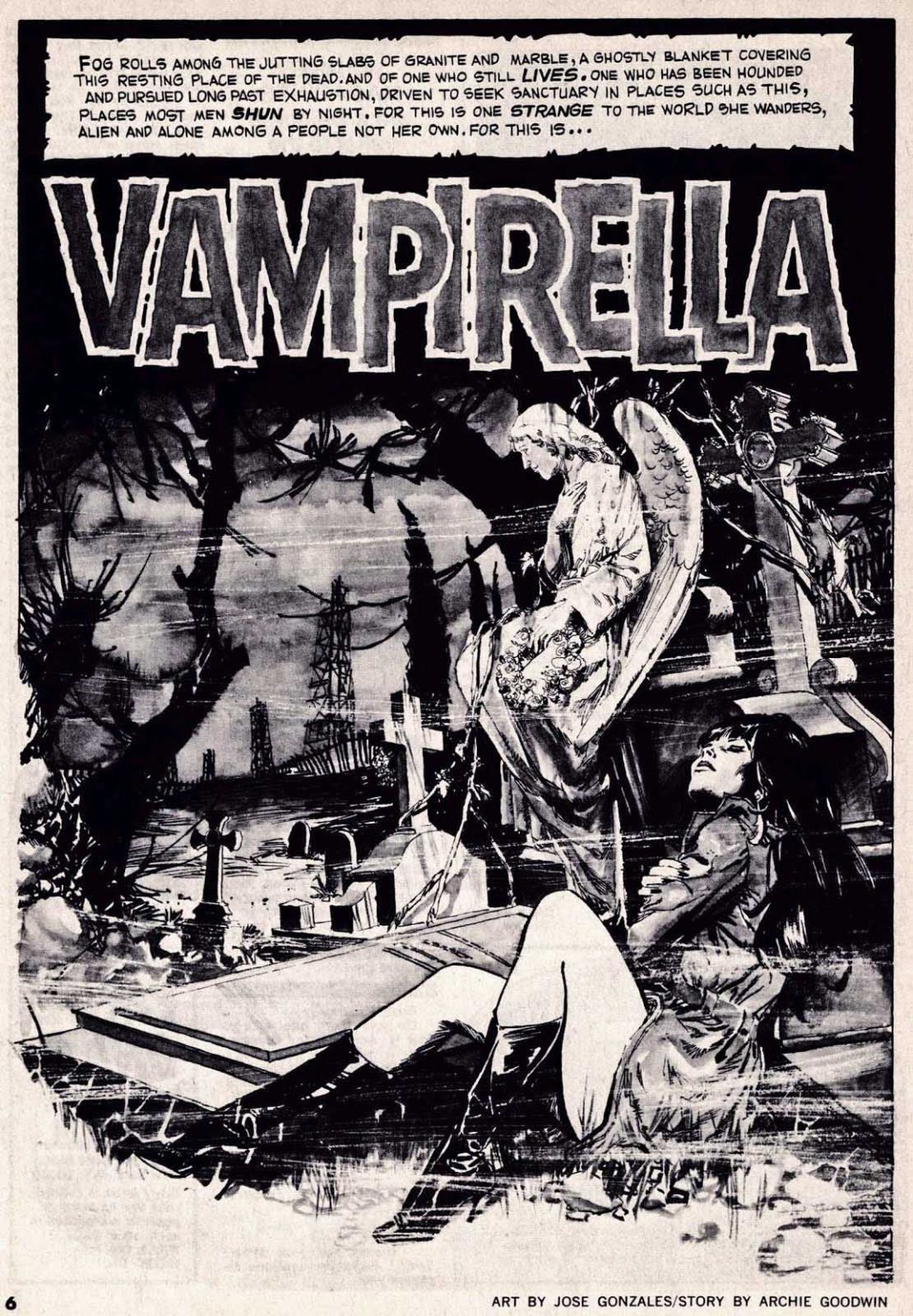This is a personal journal documenting my studies in art - mainly just a place to keep notes and to organize my thoughts better than I could in a handwritten journal (you can't do a search in a paper journal, or post live links). My ultimate goal is oil painting, but I want to start with developing my grasp of the basics in drawing.
Sunday, April 23, 2023
The Spotlight Effect
Friday, April 21, 2023
Simplify lighting
Jose Gonzales Vampirella Art Edition—this thing is gigantic!
It's a real logistics problem figuring out how to look at it. I settled on supporting it on my thighs and holding it upright with both hands. I have to lean back a bit to be able to take in the full spread. But damn, this thing is gorgeous!! It didn't feel like I was holding a book on my lap, but like I was inside it, and it might close and crush me at any moment.
The intro tells the story about that fateful day when a certain Spaniard named Josep Toutain walked into Jim Warren's office carrying a large portfolio loaded with the work of the artists of his agency, called Selecciones Illustradas (usually just abbreviated SI).
To set the stage, Warren publishing had been struggling for a while. I believe it was the end of the 60's or the early 70s, and times were tough. They were reduced to publishing mostly reprints of older material rather than commissioning new stories. Jim and his friend Forest Ackerman, who had created Famous Monsters of Filmland for him, their first magazine, had recently seen the movie Barbarella, and they decided it would be a good idea to create a new magazine and a new host for it, a sexy and beautiful vampire named Vampirella. They had already published a couple of issues, but there were problems. Ackerman had written I believe the first issue, and an artist named Tom Sutton had drawn the lead story. It wasn't quite what Warren had in mind, it was too campy and silly, and the art was comical. He wanted something much more elegant and dark, with a sort of Hammer Horror feel to it.
Well, exactly what he was looking for had just come in the door, but he didn't know it. Jim was hungry and about to leave the office for lunch when this brash Spaniard walked in clutching his portfolio and announced himself. Jim almost brushed him off, but the guy was a good talker, and in moments had captured his attention with his story.
Toutain was the creator of the agency, and had a number of incredible Spanish artists working for him. He was already selling their work to publications in France and the UK, but wanted to expand into America. He had already tried Marvel and DC comics. Jim asked it either had shown any interest, and Toutain cannily said they hadn't decided yet, but he had high hopes. Then he opened the portfolio.
Apparently the first artist represented was Jose Gonzales, and he was exactly the illustrator Warren needed for Vampirella. He knew it immediately. And as he looked through the other artists, he began to realize these guys were all perfect for large format black and white horror comics. It was as if they had been born for it.
At the time the artists were mostly if not all American, and not very well suited to drawing horror comics. Several of them were really cartoonists, and the rest were mostly superhero artists. But here was a group of amazing artists (illustrators really) with that undeniable European elegance and style that he needed. Jim forgot about lunch and started making plans. He essentially replaced all his artists with the Spaniards whose work was in that portfolio. They all remained in Spain, working at the SI office, and shipped their work by air mail.
Thursday, April 20, 2023
Richard Corben—dinosaurs, rounded forms and a claymation aesthetic
This image shows all the factors I mentioned in the title that make Corben's work great. I left one thing out though (many actually)—his amazing use of color. He was a pioneer when it came to color in comic books in the 70s. He came up with some kind of crazy way of using fax machines (I think?) to create 3-color separation plates so he could get amazing never-before-seen color work in his stories, like the cover above. He basically drew the art in black and white and then created the color separation plates by hand, and he had no way to see what the results were going to look like until it was printed. But he had such an amazing art sensibility he knew how to do it.
Refined Axe
Tuesday, April 18, 2023
Axe
Monday, April 17, 2023
Warren Horror Magazines and the Spanish Invasion
I've mentioned my love of the 70's Warren horror comics a few times and posted just a few teaser images. I think it's time to go into some more detail and post some nice eye-watering images. (Eye-watering? Is that even a thing? Sounds painful rather than a visual version of mouth-watering, which is what I was going for, but then that's actually pretty appropriate.) There were many more artists involved in the so-called Spanish Invasion of the late 70s—I'm only presenting the work here of my three favorites. I might show a few more at another time, and I'll definitely show some of the great cover paintings.
"Many American fans then and now, wondered why Warren had opted to have all those Spanish artists. The first answer that came to mind, was that they were actually Mexicans from south of the border who were getting paid minimum wage rates to slave for Warren. But truth of the matter was that Warren actually paid the highest rates at the time, no matter where the artists came from (a practice both DC and Marvel didn't apply to the Filipino artists who were getting a third of what the Americans were paid). Warren's reasoning was quite simple: the Spanish artists were good! But what made these Spanish artists so good? What many people don't know is that most of these guys started working pretty young, mostly in their teens. And as they worked among already seasoned professionals, by the time they reached their early twenties, they were already seasoned professionals as well, something most of their American contemporaries weren't because they had only just started working in the business. You can see this in some of the earlier Warren archive volumes, were the artwork done by some young American artists is quite mediocre by comparison. And even if most of the Spaniards were only in their mid-twenties to early thirties when they started working for Warren, they already had more than a dozen years of experience, which made them seem so much better that their American counterparts."The Spaniards also had a very peculiar way of drawing or inking their comics, that didn't resemble anything done in America at the time. They were also masters of working in black and white, and this was due to the fact that they worked mostly for British magazines that were only printed in B&W. They also got their peculiar style of inking from some Italian magazine of the 60's called Linus. That magazine, which got its name from a Peanuts character, featured the art of two masters of b&w inking and drawing; the Italian Dino Battaglia and the Argentine (though born in Uruguay) Alberto Breccia. Both Breccia and Battaglia had worked for the same editor in Argentina, who also happened to be the best comic book writer of all time: Hector German Oesterheld. Oesterheld got into comic books by accident, and would be among the first writers who would write specifically for an artist (pretty much like Kurtzman and Feldstein would do in EC), and a practice that the Warren writers would also follow. You can imagine the Warren writers fighting to get Maroto or Luis Garcia to draw their stories..."Alberto Breccia, the argentine artist who would inspire so many of the Spanish artists in the late 60's/early 70's, would develop his very peculiar style of inking pretty much through trial and error, and a part of genius as well. Cutting himself one morning while shaving, he pulled the razor blade out and when he was about to leave it on the sink, he noticed it left behind a series of trails pretty much like the lines he obtained while inking with a pen. This gave him the idea to use a razor blade not only to ink, but to scratch the board and so obtain different effects on his inking. This wouldn't go unnoticed among the Spaniards, who began scratching their boards with a razor blade to extreme effects (look at Auraleon's artwork to see what I mean). Breccia's extreme use of shading and shadows, leaving only slits of white on the board to give more depth to his drawings, would also be of a great inspiration to the Spaniards. Most of them discovered Breccia's work either from the same British weeklies they were all working for, or from the afore-mentioned Italian magazine. Frequent Vampirella contributor Fernando Fernandez had also lived for a couple of years in Argentina, and when he came back to Spain, he showed all his friends at SI Artists (the art studio they all worked for in Barcelona), some of the astonishing art he had found in Argentina: artists like Breccia, Jose Luis Salinas (who drew the Cisco Kid newspaper strip, and perhaps the best artist of all time along with Hal Foster), Roume and countless other Argentine artists that would inspire the Spaniards as well."Dino Battaglia, the other source of inspiration for the Spaniards, was an Italian comic book artist who in the early 50's worked for another Italian publisher who had moved to Argentina along with such Italian luminaries as Hugo Pratt and Alberto Ongaro. He used a very peculiar way of inking, working not only in heavy blacks, but with grays he obtained with a "souffle-au-cul", a sort of metal tube divided in two sections; one part went inside the ink pot, and through the other you would blow as through a peashooter. Blowing through one of the metal tubes, would cause the ink to rise through the other tube, thus obtaining an ink splattering on the surface you blew onto. This splattering, similar to what an airbrush does, but much more coarser, and depending on the force with which you blew, would appear almost gray in print. This method of graying was very much appreciated by the Spaniards, who didn't know how Battaglia obtained this effect. However, they soon discovered that by dipping a used toothbrush in ink, and then rubbing the bristles with a ruler onto their art boards, they could obtain a splattering effect. Another trick was using an old sock dipped in ink, and then applying it onto the paper. You would obtain a splatter-like effect as well. As soon as this was discovered, all the Spanish artists were either dipping their toothbrushes, socks, or any clothing with a coarse weaving, into their ink pots and applying/or rubbing them onto their art boards. These effects are used by almost the totality of the Spaniards in the late 60's/early 70's, and you can pretty much see it in all the stories they did for Warren. Add to that some scratching with a razor blade over the splatter you obtained with your socks, toothbrushes, etc., and you've got all the shading needed for a Spanish-like inking for a Warren story."Though inspired by both Battaglia and Breccia, the Spaniards came up with a hybrid-style all their own, which however wouldn't last beyond the decade of the 70's, as nobody works that way anymore."Nevertheless, back in the day, the importance of the Spanish artists didn't go unnoticed among the other artists working for Warren, as many of the non-Spanish artists were trying to emulate them too. You can see this with Paul Neary's work on "Hunter," where he tries to copy Maroto's style, and even with some stories drawn by Tom Sutton. Of special note is also Gonzalo Mayo's work, who many believe is Spanish, but is among the only two Peruvian comic artist to ever make it in America (the other one being Pablo Marcos). Mayo's work is very similar to Esteban Maroto's. And Maroto, whether you like him or not, has left an indelible mark on comic books, with his neo-classic, Mucha-influenced style of drawing."Maroto's series "Dax the warrior", by the way, was meant for Vampirella (see my review for Vampirella Archives volume 5 for further info)."
Vampirella had the chance of finding its most iconic artist as soon as the Spanish artists took over, in the person of Pepe Gonzalez. Gonzalez was an anomaly among comic book artists because he had never wanted to be one in the first place, and as a kid had never read comic books, and only got to do them by a fortuitous accident. Being a very able artist, he was hired at age fifteen to draw comic books by a fresh and newly formed art agency in Barcelona. Like most of the other artists in the studio, they worked for the European, and mostly for the British market, drawing anything from war, spy and western stories for various publishers. It wasn't until Gonzalez, or Pepe, as everyone in the agency called him, was given a western story featuring some can can dancers to draw, that they discovered he could actually draw very beautiful girls. It got to the point where every other artist in the agency would copy Pepe's girls, as he seemed to have the knack to draw them very pretty and appealing. Shortly after, he was given the assignment of drawing romance stories instead for the british market, something he preferred anyway to drawing cowboys. So it wasn't surprising that Pepe was given the chance to draw Vampirella, before any of the other artists from the Barcelona art agency. And this he did extremely well, so much that it's difficult to this day to think of another artist who better defined the look of Vampi.
The problem with Pepe was that he cared very little for comic books, preferring instead to do illustrations in pencil (something he would eventually do for Warren as well, and his pencil drawings of Vampirella are breath-taking). He hardly ever pencilled his pages, the only pencilling he'd do were a series of circles to know where he would place the characters, and then he'd draw the pictures directly with a sharpie. This method however had the drawback of leaving many disproportions in the bodies he drew. Also, for someone who claimed to be a homosexual, he seemed more interested in drawing beautiful girls than men; his male characters rendered quite hastily most of the time, and almost as an afterthought. Pepe also suffered from what's known in the business as being a "lazy artist". He was a really talented person, and not only as an comic book artist, but as a singer, a showman, an immitator, etc. The problem was that he never cared much for anything and didn't really apply himself to his work. Maybe because all this came so natural to him, he never thought of working hard at anything, and just picked the easy way out. Though among his many talents the one he said he could easily desist of, was drawing comic books. Strange, as he made a living from drawing comic books. After his stint on Vampirella, with which he pretty much stuck with until the very end of the company, he would create a couple of other series, always featuring a female lead character. He sadly passed away in 2009, having lived most of his life in the company of his mother and grandmother.
There's one more thing I want to post here, besides a collection of the amazing Warren cover paintings, and that's a brief account of how these mostly Spanish artists came to work for an American company and basically replaced all the American artists who had been illustrating the magazines. I'll dig up the info aand get it ready for when I make that post.
Saturday, April 15, 2023
Back At It!
Thursday, April 13, 2023
Some thoughts on recent posts and what I'm doing
It's starting to hit me, what I'm doing here. I've been talking about this group of artists who were active starting in the 60s, when I was a kid, up through the 90s, when I stopped being interested in comic books. And I'm comparing and contrasting them with each other and with my own art, ferreting out the influences they've had on each other and on me.
It's somewhat like doing master studies, where you pick an artist and copy a piece of his work. I've done a bunch of them for the Level Up course when I was on ConceptArt. Seems like a lifetime ago, it was about a decade I guess. Here's a few I did:
But what I'm doing now is much more focused. I'm looking specifically at this group of artists who so profoundly affected my own ideas about art as I was growing up. That's formative stuff! These guys plus a few more were it for me, well in the comics world. Then there were more of course. Right now I'm specifically looking at my comic influences. Not really sure why, it's an intuitive thing. I'm really drawn to it, and I suspect it's because they offer what I'm most missing in my work, those powerful shapes and colors and textures to bring some toughness aqnd personality to it. To pull my work out of blandsville and turbocharge it. Well, that plus of course I moved to comic figures to propel my anatomy studies.
By looking at all of their work rather than just examining the work of one artist, and generally it's one who lived a century ago or more (not always), this gives me a very deep and broad understanding of certain things. I see the diffferences in how they approach things, and the similarities. That helps you to guage things to a much finer degree, to see things you would otherwise have missed. Simply because I looked at a bunch of Texeira and then a bunch of Jae Lee, and before both of them I did a stint on Bisley. Grabbing images and video to post made me begin to notice these similarities and differences, and drew my eye to trends that were developing or being refined in ther work as it evolved across the decades and through all of them and several other artists who were peripheral to their group (not that it was really a group, I just group them together as stylistic influences on each other).
One thing I notice about all of them—They combine two things that don't frequently go together. Ultra-juvenile musclebound superhero fantasy with bulging biceps and sexy women, alongside some really sophisticated art techniques. It's always there, if you defocus on the bulging muscles and grimacing faces and sweat. Each one of them is a master in several techniques that most of their peers just didn't even come close to. Compared to the normal run of the mill comics artists, each of these guys were truly great artists. There's a solid character and personality in their figure work that's mostly lacking in the work of the general comics artist. I could do a post of a series of them comparing them with some of the weak-sauce artists of their time, but that seems counterproductive. And it would be a lot of mudslinging, what's the point of that? Oh, there were definitely some other great artists at the time, for sure! In very different ways from these powerful stylists I'm focused on. They were the superstar artists, and then you've got the lower-tier, the workmanlike artists who drew stiff figures that never really seemed solidly grounded in the scene, or just didn't have graceful gesture to them.
Some of these guys have the same problems actually, but their style is so powerful and they're so bold in their choices that it doesn't matter. It's when the artist is also tentative or too timid in his choices that you notice those issues.


















































